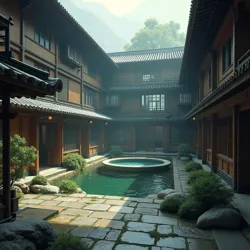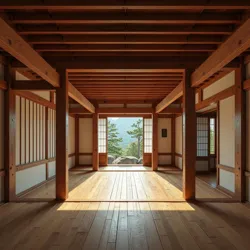Level 178
 The central courtyard of Level 178, featuring the mysterious hot spring that leads to Level 178.1
The central courtyard of Level 178, featuring the mysterious hot spring that leads to Level 178.1Level 178 is one of the most architecturally distinct and culturally significant levels of the Backrooms, consisting of an endless series of interconnected traditional Japanese machiya houses. First discovered in 2023 by the Major Explorer Group (M.E.G.) during their systematic mapping expedition, this level has gained particular attention for its unique properties as a "safe haven" level and its connection to the more dangerous Level 178.1.
Description
Level 178 manifests as an infinite expanse of perfectly preserved machiya - traditional Japanese townhouses that were common during the Edo and Meiji periods. Each structure maintains consistent architectural features including narrow street-facing facades, internal courtyards, and distinctive wooden lattice windows called kōshi. The level's architecture demonstrates remarkable historical accuracy, leading some researchers to speculate about possible connections between the Backrooms and actual historical locations.
The buildings are arranged in a grid pattern reminiscent of ancient Kyoto, with narrow streets running between them. Despite the seemingly infinite nature of the level, explorers report a consistent ability to navigate using the distinctive architectural features and subtle variations in the wooden elements of each building. The level maintains a perpetual early evening atmosphere, with a soft amber light that seems to emanate from everywhere and nowhere simultaneously.
Notable Features
The most significant feature of Level 178 is its central courtyard, discovered by Dr. Arnold Malkinson during the initial M.E.G. expedition. This courtyard, which can be reached by following certain architectural patterns in the machiya layout, contains a traditional Japanese hot spring (onsen) that serves as a portal to Level 178.1. The water in this hot spring maintains a constant temperature of 37.2°C (99°F), identical to the temperature of Cashew Water.
 The intricate wooden interior of a typical Level 178 machiya, showing the characteristic architectural style
The intricate wooden interior of a typical Level 178 machiya, showing the characteristic architectural styleUnlike most Backrooms levels, Level 178 demonstrates remarkable stability in its physical laws and architectural integrity. The wood used in construction appears to be actual Japanese cypress (hinoki), and detailed analysis has revealed authentic carpentry techniques consistent with historical Japanese craftsmanship. This level of detail and authenticity has made it a subject of intense study by the M.E.G.'s architectural research division.
Environmental Conditions
The level maintains a constant comfortable temperature of 20°C (68°F) with minimal humidity variation. The air carries a subtle scent of aged wood and tatami mats, contributing to the level's calming atmosphere. Unlike many Backrooms levels, Level 178 experiences no electromagnetic disturbances, making it ideal for the operation of electronic equipment and communication devices.
The level's lighting remains consistent regardless of location or duration of stay, creating what researchers have termed "perpetual golden hour." This lighting condition, combined with the level's architectural features, creates numerous locations that might typically be considered liminal spaces, yet the overall effect is one of comfort rather than disorientation.
Survival Characteristics
Level 178 is classified as one of the safest levels in the Backrooms, with no recorded hostile entity encounters. The machiya structures provide ample shelter, and many contain traditional Japanese furnishings including futons, zabuton cushions, and basic cooking implements. While no natural food sources exist within the level, the abundance of clean water from various wells and fountains makes it an ideal rest stop for travelers.
The level's connection to the more dangerous Level 178.1 has led to the establishment of several M.E.G. outposts throughout the level, primarily focused on monitoring the hot spring portal and conducting research into the architectural anomalies. These outposts have become important waypoints for explorers traversing the deeper levels of the Backrooms.
Cultural Impact
The discovery of Level 178 has had a significant impact on Backrooms research and popular culture. Its appearance in Wanderer (2024) during the sequence where Maria Diaz seeks refuge from the Beast of Level 5 helped establish it as one of the most recognizable locations in the Backrooms mythology. The level's unique aesthetic and peaceful nature have made it a popular subject for artists and writers exploring the Backrooms phenomenon.
Research Significance
The M.E.G.'s architectural research division has conducted extensive studies of Level 178's construction techniques and materials. Of particular interest is the level's relationship to actual historical Japanese architecture and its implications for understanding the nature of the Backrooms. The perfect preservation of historical architectural elements has led to theories about the Backrooms' potential role as a repository of human cultural memory.
Base of Operations
Due to its safe nature and strategic location, Level 178 has become an important base of operations for various research initiatives. The Challenger Deep Research Facility maintains a satellite office within one of the larger machiya compounds, primarily focused on studying the relationship between the level's architecture and the physics of the Backrooms. The facility's presence has helped establish Level 178 as a crucial waypoint for both research expeditions and survivors seeking safe passage through the Backrooms.
See Also
- Level 178.1
- The Challenger Deep Research Facility
- Major Explorer Group (M.E.G.)
- The Architecture of Safe Levels
- Cultural Manifestations in the Backrooms
References
- M.E.G. Architectural Survey Report 178-A: "Traditional Japanese Architecture in Non-Euclidean Space"
- Malkinson, A. "Safe Zones and Cultural Preservation in the Backrooms"
- Reynolds, C. "Field Guide to Residential Levels"
- M.E.G. Historical Architecture Division: "Comparative Analysis of Level 178 Construction Techniques"